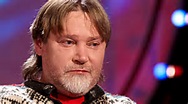Jan Sandström and Urmas Sisask
The era of spiritual minimalism has encouraged composers and performers to range widely, and to explore many sources—musical, religious, and philosophical-- in search of inspiration. One recurring theme in the biographies of our November concert composers is the interest in early church music—especially Gregorian chant and Renaissance polyphony. The composers are drawn to the seeming simplicity of this music, to its starkness, to its capacity to inspire emotion and wonder out of almost nothing. I remember rehearsing Pärt and Gorecki pieces with Robert Shaw, and his somewhat frustrated comment that their music reminded him of crawling back into the womb. That is a strangely is a valid description of what the composers are attempting: a radical return to the most fundamental materials and meaning of music, and to the meaning of silence—where does music come from? Why do we do it?

Two of the most experimental composers on our program are Jan Sandström (b.1954) and Urmas Sisask (b.1960). Sandström was born in the far North of Sweden, at the top of the Gulf of Bothnia, near the town of Piteå, and is now Professor of Composition at the College of Music there. I spent several weeks at that school, about twenty-five years ago, and found it to be a very surprising and inspiring place—an island of intense energy and creativity in the midst of lakes, birch trees, and silence. I was there during the eternal light of summer; I cannot imagine what it must be like during the winter. Such an environment must inevitably invite one to question the patterns and assumptions that sustain life in more normal settings. Sandström is most famous for his Motorbike Concerto for trombone and large orchestra, and for his setting of Es ist ein Ros entsprungen for 8-part chorus at a glacially slow tempo. He began his compositional career writing in an austere, theoretical, sophisticated, densely-constructed idiom, making using of spectral techniques (composition based on analyses of overtone registers). Then, in the late 1980’s he shifted toward a more minimalist style. A review of his 2008 Rekviem summarised: "99% Pärt, 1% Bach". Gloria, the work we will sing on our program, falls squarely within this latter style.
Estonian composer Urmas Sisask graduated from the Tallinn Conservatory in 1985, and, unlike his compatriot Pärt, has spent his entire compositional life in Estonia, focusing on the culture and folk music of that particular locale. He is described as both composer and amateur astronomer, but these two activities are in fact closely interlinked. He lives in the small, remote village of Janeda, where he has built his own observatory, and where he gives concerts and lectures in his Musical Planetarium situated in the tower of an old manor house. He has worked out theoretical sound values for the rotations of the planets in the solar system. This reduces to a planetal scale' of five tones: C-sharp, D, F-sharp, G-sharp and A. This scale forms the melodic and harmonic basis for many of his later compositions, though not for Benedictio, the work Chorale will present. Benedictio reflects, rather, another of Sisask’s strong interests, the shamanic pre-Christian religion indigenous to the Baltic region, and the folk music associated with it. He has developed his own, expressive musical language based upon these influences, which, with its constant reference to perfect fourths and fifths, is harmonically closer to old church modes than to the diatonic, major/minor system utilized by Pärt and Sandström. Benedictio is set in an incantatory style, based upon repeated, hypnotic rhythmic and melodic patterns, building to enormous, almost bacchanalian climaxes, unlike anything heard in the gentler and subtler music of our other chosen composers.

